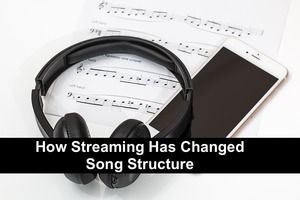- in Production by Bobby Owsinski
How Streaming Has Changed Basic Song Structure
 Streaming has changed music in oh so many ways, but one area that’s overlooked is the basic form of hit songs. In case you haven’t been paying attention (and you might not have), hit songs these days are way different than in the past. If you looked at hits from way back in the 50s to around 2015, the song structure was pretty similar and looked something like this:
Streaming has changed music in oh so many ways, but one area that’s overlooked is the basic form of hit songs. In case you haven’t been paying attention (and you might not have), hit songs these days are way different than in the past. If you looked at hits from way back in the 50s to around 2015, the song structure was pretty similar and looked something like this:
Intro → verse → B section → chorus → intro → verse → B section → chorus → bridge → chorus → chorus (fade)
It’s actually difficult to find songs with this form anymore thanks to streaming. Martin Connor provides a great overview complete with examples on how song structure has changed, but after analyzing dozens of songs on my Deconstructed Hits webinars for my Hit Makers Club members, here’s how I see it:
1. Songs start right in on the chorus. There’s a good reason for that too. Because of our quick attention span world, if you don’t grab a listener right away you might lose him or her. An artist can’t afford to expect a listener to wait 15 seconds before the singing begins and about a minute until the song’s chorus enters, since you’ll probably lose them, especially if they’re not already familiar with the song. Hence, hits today get right to the point as soon as possible.
2. There are no bridges. The bridge was traditionally the peak of development of the song, and although the choruses afterwards maintained a similar high intensity, there was usually a fade at the end instead of a hard ending. Today’s hits still have plenty of development, but the peak usually comes in the last chorus rather than a bridge.
3. There are no fades. Most hits today have hard endings with some being more eloquently designed than others (some just feel like an abrupt stop because nothing else was recorded). Actually there’s no need for a fade today. The long intro and the fade out of the song was primarily designed for radio DJs to talk over, and since today’s hits care little about radio, why insert a section that caters to its needs?
4. There are no solos. Go ahead and try to find a hit with anything that even comes close to a traditional “solo.” You’ll be hard pressed to find one these days. Artists, producers and musicians aren’t concerned about learning to whip a solo out because there’s no longer a need to lengthen what might be considered a short song.
5. Songs are shorter than ever. You get paid the same regardless if a song is 1:40 or 4:40 so why not make it short? Maybe the person will play it a second time and you’ll get paid twice, rather than hear a longer version to the end and have no desire to play it again. Once again, the short attention span plays into even the length of songs by making song structure even simpler.
6. Songs are somewhat homogenized thanks to so many collaborators. It’s rare to find a single songwriter or even a duo team on a song these days. You’re more likely to find 10 or more, and perhaps that many on the production team as well. Some of this can be attributed to the “cover your butt” mentality of avoiding lawsuits down the line, but much of it is corporate in nature in trying everything to obtain the most desired outcome (that doesn’t mean a good song, it means a hit). That’s not exactly the way to set a new trend or think outside-the-box, but that’s not the nature of songwriting today.
Keep in mind that I’m not saying that the change in song structure is contributes to “bad” music (that’s so subjective anyway). It’s just different from the way it was done previously. Like everything else, music creation and music tastes change with the times. It’s not good or bad, it’s just a fact.

